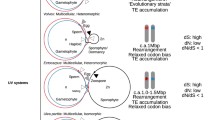Abstract
Two closely related commercially cultivated oyster mushroom species, Pleurotus pulmonarius and P. sajor-caju have been differentiated by traditional mating experiments as well as analysis of the variable ITS and IGS sequences of the ribosomal gene cluster. Molecular analysis of the variable ITS and IGS regions has allowed neither reliable differentiation between the morphologically similar species P. pulmonarius and P. sajor-caju nor confirmation of species identity of the P. sajor-caju strains CS-32, H-1, and H-2. Analysis of the sexual (mating) compatibility between haploid tester strains of these two species in monokaryon-monokaryon mating experiments has demonstrated complete reproductive isolation between P. pulmonarius and P. sajor-caju, thereby confirming that these are separate species.
Similar content being viewed by others
References
Bonatti, M., Karnopp, P., Soares, H.M., and Furlan, S.A., Evaluation of Pleurotus ostreatus and Pleurotus sajorcaju Nutritional Characteristics When Cultivated in Different Lignocellulosic Wastes, Food Chem., 2004, vol. 88, no. 3, pp. 425–428.
Zhuang, C., Li, W., and Chen, S., Antitumor Protein-Containing Polysaccharides from a Chinese Mushroom Jengweigu or Houbitake, Pleurotus sajor-caju (Fr.) Sing, Boisci. Biotechnol. Biochem., 1993, no. 57, pp. 901–906.
Ngai, P.H. and Ng, T.B., A Ribonuclease with Antimicrobial, Antimitogenic and Antiproliferative Activities from the Edible Mushroom Pleurotus sajor-caju, Peptides, 2004, vol. 25, no. 1, pp. 11–17.
Lakshmi, B., Tilak, J.C., Adhikari, S., et al., Inhibition of Lipid Peroxidation Induced by γ-Radiation and AAPH in Rat Liver and Brain Mitochondria by Mushrooms, Curr. Sci., 2005, vol. 88, no. 3, pp. 484–488.
Kashangura, C., Hallsworth, J., and Mswaka, A., Phenotypic Diversity amongst Strains of Pleurotus sajorcaju: Implications for Cultivation in Arid Environments, Mycol. Res., 2006, vol. 110, no. 3, pp. 312–317.
Chiua, S.W., Chana, Y.H., Lawa, S.C., et al., Cadmium and Manganese in Contrast to Calcium Reduce Yield and Nutritional Values of the Edible Mushroom Pleurotus pulmonarius, Mecoplogist, 1998, vol. 12, pp. 56–64.
Idowu, O., Evaluation of Different Substrates and Combinations on the Growth of Pleurotus pulmonarius (Fries) Quelet (P. sajor-caju), Nigerian J. Hortic. Sci., 2003, vol. 8, pp. 112–221.
Corner, E.J.H., The Agaric Genera Lentinus, Panus, and Pleurotus with Particular Reference to Malaysian Species, Nova Hedwigia, 1981, vol. 69,suppl., pp. 1–169.
Kurtzman, R.H. and Zadrazil, F., Physiological and Taxonomic Considerations for Cultivation of Pleurotus Mushrooms, Tropical Mushrooms: Biological Nature and Cultivation Methods, Chang, S.T. and Quimio, T.H., Eds., Hong Kong: Chin. Univ. Press, 1982, pp. 299–348.
Pegler, D.N., The Genus Lentinus, Kew Bull. Additional Ser., 1983, no. 10, pp. 1–281.
Hilber, O., Valid, Invalid and Confusing Taxa of the Genus Pleurotus, Mushroom Sci., 1989, vol. 12, pp. 241–248.
Altukhov, Yu.P., Species and Speciation, Sorosovsky Obrazovatelny Zh., 1997, no. 4, pp. 1–10.
Eger, G., Biology and Breeding of Pleurotus, in The Biology of Cultivation of Edible Mushrooms, New York: Academic, 1978.
Shnyreva, A.V., Druzhinina, I.S., and D’yakov, Yu.T., Genetic Structure of the Pleurotus ostreatus sensu lato Complex in Moscow Region, Russ. J. Genet., 1998, vol. 34, no. 12, pp. 1371–1378.
Vilgalys, R. and Sun, B.L., Assessment of Species Distributions in Pleurotus Based on Trapping of Airborne Basidiospores, Mycologia, 1994, vol. 86, no. 2, pp. 270–274.
Zervakis, G. and Balis, C., A Pluralistic Approach in the Study of Pleurotus Species with Emphasis on Compatibility and Physiology of the European Morphotaxa, Mycol. Res., 1996, vol. 100, no. 6, pp. 717–731.
Lee, S.B., Milgroom, M.G., and Taylor, J.W., A Rapid, High Yield Mini-Prep Method for Isolation of Total Genomic DNA from Fungi, Fungal Genet. Biol., 1988, vol. 35, pp. 23–24.
Sambrook, J., Fritsch, E.F., and Maniatis, T.A., Molecular Cloning: A Laboratory Manual, New York: Cold Spring Harbor Lab., 1989.
Nilsson, R.H., Kristiansson, E., Ryberg, M., et al., Intraspecific ITS Variability in the Kingdom Fungi as Expressed in the Internal Sequence Databases and Its Implications for Molecular Species Identification, Evol. Bioinform., 2008, vol. 4, pp. 193–201.
Hall, T.A., BioEdit: A User-Friendly Biological Sequence Alignment Editor and Analysis Program for Windows 95/98/NT, Nucleic Acids Symp. Ser., 1999, vol. 41, pp. 95–98.
Tamura, K., Peterson, D., Peterson, N., et al., MEGA5: Molecular Evolutionary Genetics Analysis Using Maximum Likelihood, Evolutionary Distance, and Maximum Parsimony Methods, Mol. Biol. Evol., 2011, vol. 28, pp. 2731–2739, www.kumarlab.net/publications.
Stamets, P., Growing Gourmet and Medicinal Mushrooms, Berkley: Ten Speed Press, 1993.
Garibova, L.V. and Sidorova, I.I., Griby (Mashrooms), in Entsiklopediya prirody Rossii (Encyclopedia of the Nature of Russia), Moscow, 1997.
Shnyreva, A.V., Genesystematics and the Species Problem in Fungi: Approaches and Solutions, Mikol. Fitopatol., 2011, vol. 45, no. 3, pp. 209–220.
Shnyreva, A.V. and Shtaer, O.V., Differentiation of Closely Related Oyster Fungi Pleurotus pulmonarius and P. ostreatus by Mating and Molecular Markers, Russ. J. Genet., 2006, vol. 42, no. 5, pp. 667–674.
D’yakov, Yu.T., Reproductive Systems and Their Evolution in Fungi, Mikol. Fitopatol., 1999, vol. 33, no. 3, pp. 137–149.
Mayr, E., Principles of Systematic Zoology, New York: McGraw-Hill, 1969.
Anderson, J.B. and Kohn, L.M., Genotyping, Gene Genealogies and Genomics Bring Fungal Population Genetics above Ground, Trends Ecol. Evol., 1998, vol. 13, no. 11, pp. 444–449.
Shnyreva, A.V., Population Genetics of Mushrooms, Mikologiya segodnya (Mycology Today), D’yakov, Yu.T. and Sergeev, Yu.V, Eds., Moscow: National Academy of Mycology, 2007, pp. 195–225.
Author information
Authors and Affiliations
Corresponding author
Additional information
Original Russian Text © A.A. Shnyreva, A.B. Sivolapova, A.V. Shnyreva, 2012, published in Genetika, 2012, Vol. 48, No. 11, pp. 1260–1270.
Rights and permissions
About this article
Cite this article
Shnyreva, A.A., Sivolapova, A.B. & Shnyreva, A.V. The commercially cultivated edible oyster mushrooms Pleurotus sajor-caju and P. pulmonarius are two separate species, similar in morphology but reproductively isolated. Russ J Genet 48, 1080–1088 (2012). https://doi.org/10.1134/S1022795412110105
Received:
Published:
Issue Date:
DOI: https://doi.org/10.1134/S1022795412110105




